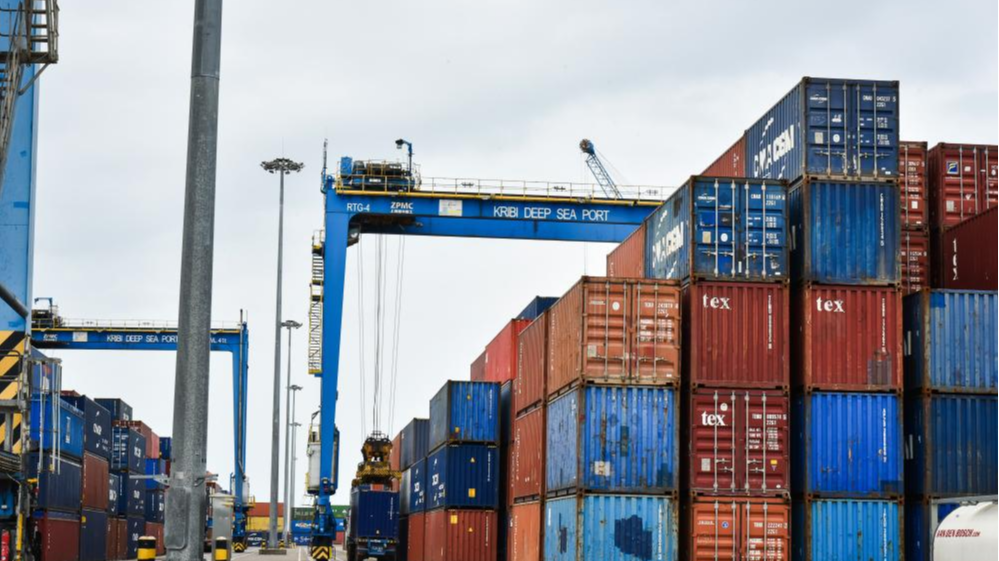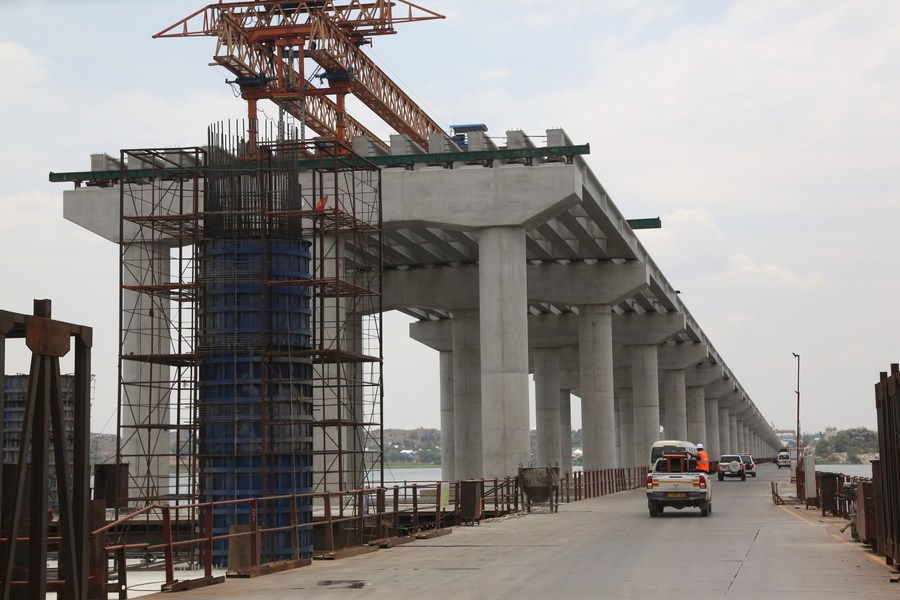
Trains of the Mombasa-Nairobi Railway in Nairobi, Kenya, May 23, 2023. [Photo/Xinhua]
Editor's note: China and Africa share a longstanding friendship, respecting, appreciating and supporting each other consistently during the past several decades. The results of their cooperation in infrastructure development, agriculture, healthcare and education have been undeniable. However, some Western media and politicians continue to accuse China of debt traps, neo-colonialism and more. CGTN's new series "China-Africa Cooperation: Debunking Western Myths" aims to put the record straight. This is the first article in the series.
By Hannah Ryder, Jade Scarfe, Rugare Mukanganga
For years, there have been sweeping concerns of African countries falling "victim" to a Chinese "debt trap" – whereby Chinese lenders provide unsustainable loans to African countries. Such narratives are problematic, as African countries are portrayed as inferior or incompetent in their engagement with Chinese creditors, while their Chinese counterparts are presented as predatory in their engagement with Africa. Indeed, throughout the COVID-19 pandemic, we witnessed these narratives emerging once again, despite vast amounts of data debunking this theory.
This narrative is also extremely harmful, as it downplays the agencies of African governments in being proactive in taking out loans to finance their development. Actually, the concept of debt traps has an underlying connotation that African governments need to be saved from bad negotiations with China or others, and generally that African governments negotiate badly.
So, before getting into the issues of the debt trap narrative, it's important to take stock of the current rhetoric. We must put the continent's external debt levels into perspective, which shows us it's not all doom and gloom, and in fact, there are many opportunities across the continent.
In 2022, the continent's external debt levels stood at $1.12 trillion. Yet, our analysis suggests that while current narratives continue to stress external debt levels are overburdening African countries, it's important to look at this from another perspective.
For example, for the continent, external debt stands at 40 percent of Gross National Income (GNI), well below the 1994 peak of 77 percent. Further, this varies drastically per country. For instance, Mozambique and Mauritius had external debt-to-GNI ratios of 424 percent and 137 percent, respectively, in 2022; whereas Algeria and Botswana have the lowest external debt-to-GNI ratios of about 4 percent and 10 percent, respectively. So, whilst some countries are facing increasing fiscal pressures, to claim that "Africa" is facing a debt crisis is simply misleading.
Nevertheless, what remains true is that the continent needs finance, now more than ever, to support economic recovery after many turbulent years of economic shocks. We estimated the infrastructure financing needs of just 13 African countries to meet the Sustainable Development Goals and Agenda 2063 and found an investment gap adding up to $108.9 to $149.9 billion a year to 2030. According to African Development Bank estimates, the entire continent faces a $402.2 billion annual finance gap in its goal of accelerating structural transformation by the year 2030, or $86.7 billion under the Agenda 2063 deadline. About 76 percent of these resources would target road and energy infrastructure alone.

A view of Nairobi, capital of Kenya, July 8, 2023. [Photo/Xinhua]
When addressing this China "debt trap" narrative, there are three key points. First, when thinking of this so-called debt trap, it's critical to take a complete view of the continent's lending landscape.
Many skeptics on Chinese lending, fail to take a holistic view. The key issue here is that often large numbers are presented and attributed to Chinese lending without comparison to others.
Indeed, as of 2022, the continent's total bilateral debt to China amounted to about $63 billion. On its own, this seems like a significantly large debt. However, this accounted for just 6 percent of the continent's total external debt. Comparatively, Africa's private sector debt makes up about 43 percent of the continent's external debt, while multilateral debt represents about 34 percent of total external debt. Excluding China, other bilateral lenders collectively accounted for approximately 8 percent of the continent's external debt.
Other bilateral lenders used to lend to African countries in a similar degree to China – yet this has slowed down significantly. For example, loans from the UK and the U.S. represented 8 percent and 10 percent of the continent's external debt in 1970. In 2000, these proportions had slid down to 2 percent for the UK, and 5 percent for the U.S. As of 2022, these figures were much lower at 1.41 percent and 0.68 percent, respectively.
Additionally, the cost of lending from China varies. For example, the Export-Import Bank of China has an average interest rate of 3.6 percent for the continent. Comparatively, private sector loans can have extremely high interest rates – as high as 10 percent – due to biased risk perceptions of the continent.
Conversely, multilateral development banks (MDBs) and Bretton Woods institutions also have "hidden costs" associated with them, due to extensive conditionalities requiring African countries to make policy changes which may not be in their best interest. This was demonstrated recently by the mass protests in Kenya in response to proposed tax hikes Kenya's Treasury pushed forward as part of required IMF reforms before securing a new loan.
Second, the quality of debt spent matters. When external debt is spent on recurrent expenditures, such as budgetary support, it can free up fiscal space. However, this debt isn't productive – as it's not producing financial returns for repayments.

A view of the Kribi Deep Sea Port in Kribi, Cameroon, March 15, 2022. [Photo/Xinhua]
African countries often secure Chinese financing to support productive sectors – such as infrastructure development. Between 2000 and 2022, Africa had secured around $116 billion in loans for infrastructure development, with Southern and East Africa holding about 43 percent and 25 percent, respectively.
These internal investments by African countries are proactive efforts to generate long-term, sustainable economic growth that dilutes the current burden of servicing expensive and highly conditional external debt.
In contrast, other partners are not meeting Africa's financing needs. For example, many MDBs are not financing productive sectors like infrastructure development. Indeed, the World Bank has not funded an independent new rail project since 2002.
This is a similar case for many bilateral partners. For example, in 2023 U.S. organizations financed just three infrastructure projects, versus nine infrastructure projects financed by Chinese organizations in the same year.

The construction site of the Magufuli Bridge project over Lake Victoria in Mwanza, Tanzania, September 9, 2023. [Photo/Xinhua]
Third, the real issue is a lack of cheap, concessional finance on a global scale. Africa's development finance needs are massive, yet the volumes and quality of funds received by the continent pale dismally.
For instance, according to the latest Nationally Determined Contributions, Africa needs approximately $3 trillion, with a large chunk of these finance needs distributed among the continent's 28 most climate-vulnerable countries.
However, recent global climate finance mobilization efforts like the annual $100 billion goal set by the Conference of Parties (COP) had accumulated arrears of about $27 billion between 2020 and 2021. Moreover, this form of annual climate finance comes as loans, falling short of the type of finance needed by African countries to meet huge development needs.
The fact of the matter is that there is no China-Africa "debt trap" – but there is an African demand for cheap and productive debt. China, as a steadfast partner to African countries, can set the bar on how to deliver this.
Hannah Ryder is the CEO of Development Reimagined, an award-winning African-led and African-owned international development consultancy based in Beijing. Jade Scarfe is the development finance programs manager at Development Reimagined. Rugare Mukanganga is an economist and analyst at Development Reimagined.

 中文
中文



